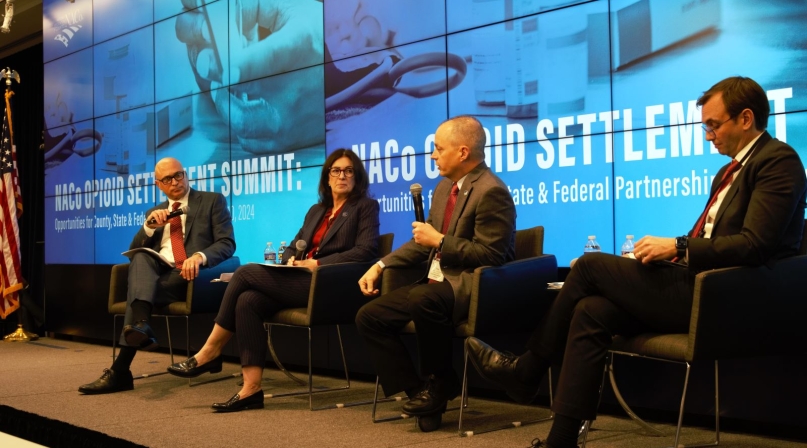Opioid fight gets resources, faces pitfalls after settlement

Key Takeaways
Virginia counties have done a lot of the work in the wake of the opioid epidemic — law enforcement, social services, family support — but they have not been the actual provider of behavioral health services.
Following the settlement of the multidistrict litigation against pharmaceutical manufacturers, distributors, marketers and retailers, those counties are finding themselves to be one of the few parties eligible to receive their share of $54 billion. Grants from that settlement will go to compensate counties for the work they’ve done in response and to fund ongoing efforts to treat and prevent substance use disorder.
Tony McDowell, executive director of the Virginia Opioid Abatement Authority, thinks that won’t necessarily be bad.
“By and large, Virginia local governments’ role has been on the response side. I think if you get county governments off the sidelines and get into the prevention/treatment/harm reduction piece of the puzzle, I think we’re going to see the tide turn,” he said during NACo’s Opioid Settlement Summit Jan. 10 in Washington, D.C. “It’s because of the leadership and the ability to get things done at the local level that we’ll get there.”
Learn more
Although 30% of Virginia’s settlement funds will go directly to counties, 55% percent will go to the Opioid Abatement Authority, which divides that portion among cities and counties (15%) and partnerships among several counties and cities (35%), with the rest going to state agencies and an unrestricted fund. It will be up to governments to award contracts to service providers, which will bring county supervisors into a new realm, adding their insights into the process.
Association of Oregon Counties Executive Director Gina Nikkel voiced similar optimism for the future of the county role in follow-through in her state.
“We’ve gone through a decade of not working very closely with the state and not having the local government authority respected,” she said.
“We have a brand-new Oregon Health Authority director and I’m really excited about that. The assistant director who’s been filling in has been remarkable and when she came on board, I told her we need to make sure that we have counties and the state working together.”
The settlement process is three years into an 18-year process, with equal payments coming annually from each of the largest distributors.
The opioid settlement has often been compared to the Tobacco Master Settlement Agreement, which was often maligned for the diversion of much of the $206 billion away from resources dedicated to combating tobacco use. Virginia’s abatement fund has offered an incentive to keep counties focused.
“We were very concerned in Virginia that our localities, understandably, wouldn’t understand all the rules and could very easily think that they have more flexibility than they actually do,” McDowell said.
If they use all of their opioid settlement funding for prevention, treatment or reduction efforts, the abatement fund will award them an additional 25% of their allocation.
Nikkel warned that while the settlement seems like a lot of money, substance use disorder has not stopped growing and costs will continue to add up.
“It is a lot of money, but it’s not enough money to do everything that we need to do,” she said. “I would caution you to make sure that whatever your groups are doing in in your state, that they act …[like] this money is only going to cover so much.”
But beyond the money coming to counties from the settlement, Daniel Hinkle, senior state affairs counsel for the American Association for Justice, said the action that counties took made a difference.
“It’s not just the money that they brought in. They stopped their activities, Johnson & Johnson stopped distributing opioids because of this litigation,” he said. “It was only because you all came together to hold them accountable that we really got our first traction and trying to end this epidemic.”
Stephen Acquario, executive director of the New York State Association of Counties concurred.
“We couldn’t have done this without using the counties to force change,” he said. “I’ll never forget talking to a former county official in our state who asked why we would do the pharmaceutical industry, that they’re a good employer right in our county.
“We had to break through that mindset and explain what was happening — that it was well beyond the capacity of being a good neighbor.”
Going on the offensive
Rahul Gupta, director of the White House Office of National Drug Control Policy, shared optimism for how the country can change course on the opioid epidemic.
“Treatment has become more accessible in the last two or three years,” said Gupta, who previously served as public health director in Kanawha and Putnam counties in West Virginia. “We have more telehealth. That means that people, no matter where they are, can get treatment.”
He said the nation and counties can address the demand and supply sides, and the national drug control plan addressed both aspects. And doctors were already responding.
“I do think that we are seeing a significant shift over the last decade or so in over-prescribing trends,” he said.
Connecting incarcerated people with substance abuse disorder treatment and supplying them with naloxone and overdose training could drastically reduce overdoses within days of their release, he noted.
“Common sense says that let’s make sure that they get the treatment while they’re in the jail so that when they come out, not only is it improved to not have reincarceration chances but also improve the economy of your community,” he said.
Making naloxone available over the counter has not only removed barriers to the supply but has made individuals more familiar with its use, he noted.
“I like to see this as available as an automatic defibrillator or a fire extinguisher,” Gupta said.
He also stressed the importance of education campaigns that can teach young people the dangers of buying illicit drugs online, along with the likelihood that they could be laced with fentanyl.
Gupta also said it is crucial for more cargo vehicles to be screened at border crossings, noting that 90% of opioid smuggling come via legal ports of entry. That and continued support of the High Intensity Drug Trafficking Areas program would serve as a force multiplier to support local law enforcement efforts.
All of these programs and measures are designed to work and be funded in concert with the opioid settlement.
“The settlement funds, I strongly believe, are to support, not supplant, the federal and state and local resources that are available,” he said. “What I found is the secret here is awareness — it’s important for county-level elected officials to be aware of what dollars are eligible from the federal government, from the state and what is coming down and the differential between the two, so we can hold each other accountable.
“We predict that we can the trajectory of this crisis and save tens of thousands of lives. If we get this right, we’re going to save so many people’s lives that we’re going to be able to make communities not only healthier, but also economically stronger.”
Miriam Delphin-Rittmon, administrator for the Substance Abuse and Mental Health Services Administration (SAMHSA) said that support for harm reduction measures would help reduce overdose rates.
First Responders Comprehensive Addiction and Recovery Act Grants, for example, will train first responders to use naloxone. The Consolidated Appropriations Act of 2023 extended the ability to prescribe buprenorphine for the treatment of opioid use disorder. SAMHSA’s harm-reduction framework was designed with the social determinants of health in mind, which Delphin-Rittmon said will makes the policy more effective.
“It’s actually the first time that there’s been a concerted collaborative coordinated effort across government around implementing harm reduction in the community level,” she said. “We’re really, really excited about that.”
Latika Davis-Jones is secretary of the Pennsylvania Department of Drug and Alcohol Programs, an 11-year-old agency which funds and monitors 47 single county authorities, along with several multi-county authorities.
She noted the increasing importance of using fentanyl test strips to evaluate the purity of drugs as part of the harm-reduction approach.
“We’re seeing a significant increase in deaths where fentanyl is now being combined with non-opioid drugs like cocaine, methamphetamines and benzodiazepine,” she said. “This really underscored the need for us to provide education and resources such as tactics like carrying naloxone and making sure that individuals have access to test strips.”
“We definitely have the evidence to suggest that poly-substance use is real and the ability to treat not only alcohol produced this order in combination with other drug use is an urgent need.”
Davis-Jones also noted a growing racial disparity among overdose deaths in Pennsylvania.
“It was also a major driver as to why we used $6 million of our opioid settlement funds to provide grants to BIPOC-led and BIPOC-serving organizations across the Commonwealth,” she said.
Gregory Branch, director and health officer for Baltimore County, Md.’s, Department of Health and Human Services, said stigma remains a barrier to recovery.
“We go around the community to talk about addiction… showing them that these are people, who are real people, with real goals and dreams who happen to have this disorder. It changes their mentality and their thought process as to how they’re going to relate to them, so we’ve got to decrease that stigma.”
Funding remains, as it has, the major question for just how much counties can do to address substance use disorder in their communities.
“The work that we do at the county level lives and dies in relationship to the grants that we receive,” Branch said. “Counties have been excellent stewards of resources and the funding streams made available to us, and we’ve been able to work with our local and state and federal partners toward more successful outcomes.”
But he warned that too many strings can get messy. As additional synthetic drugs like fentanyl and xylazine may fall outside of the bounds of certain grants and can leave counties behind as the opioid-based drug arms race escalates.
“These partnerships that we have could be strengthened by allowing more flexibility as it relates to the utilization of funding streams,” he said. “Too often, grants are very, very, very prescriptive. They don’t allow for us to work at the local level and to be as successful as possible.”
Related News

County Countdown – Dec. 15, 2025
Every other week, NACo's County Countdown reviews top federal policy advocacy items with an eye towards counties and the intergovernmental partnership.
Stretching small opioid settlement allocations helps funding do more
States and localities are set to receive $56 billion in opioid settlement dollars over an 18-year period, but not every county that receives settlement funding will get enough to build out infrastructure.
Featured Initiative
Opioid Solutions Center
NACo's Opioid Solutions Center empowers local leaders to invest resources in effective treatment, recovery, prevention and harm reduction practices that save lives and address the underlying causes of substance use disorder.

